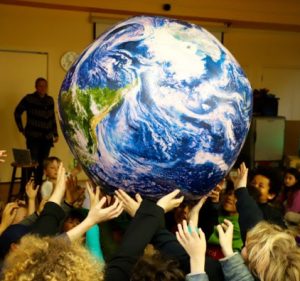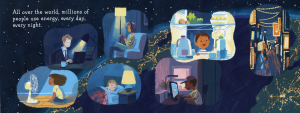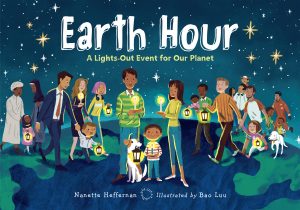
Northern Dawn Awards had the pleasure of chatting with Nanette Heffernan last month. Her book, Earth Hour: A Lights-Out Event for Our Planet , won in the Holiday/Notable Days Category in the Northern Lights Book Awards for 2020. Earth Hour : A Lights-Out Event for Our Planet was truly a labor of love for Heffernan.
NDA: Can you tell us a little bit about your writing journey and how you came about being a published children’s author?
NH: Sure. So, I come from the business world, 20 years as VP of Sales & Marketing. I’ve written more than my fair share of very dry white papers, grant proposals, business proposals, websites, and so on. When my husband and I sold our business, and he said, “What do you want to do?” I said, “Well, I’ve always wanted to be an author.” And he said, “Well, will you regret it when we’re 80 if you don’t try?” I said, “I think I will.” So that’s how I got started. I’m a pretty big environmental activist and work with a lot of kids’ programs, so I chose to marry the two.
NDA: With your home life, three children, plenty of pets, most notably eight chickens all named Companion, where do you find time to schedule in writing?
NH: I write everywhere. I do a lot of hiking, so I write on the hiking trail. I keep notes on my phone, driving the kids around, picking the kids up. I try to carve out [time] because writing is a thought process that we go through. It’s the strategy, it’s getting to know your characters, planning, plotting, and all of that. When I’m working on a picture book, I will often carry a paper draft around with me in case I have an idea. If I’m working on a novel, I make notes to myself all day long.
NDA: I’m pretty much the same way. The story is always up here (pointing to my head), and you’ve just got to get it on paper somehow.
NH: Exactly. And then I try to carve out two quiet hours a day to take all those notes in and make them sound good.

NDA: Can you explain what Earth Hour is and what inspired you to write a book about it?
NH: Earth Hour is an event coordinated by the World Wildlife Fund, and it happens on a Saturday near the Equinox of March every year. It’s different depending on certain religious holidays and when the Equinox falls. This year, 2021, it’s March 27th. And wherever you are on the planet at 8:30 p.m., you turn your lights off for an hour. It really is a pledge. It’s not about the energy you’re saving for that hour, it’s a pledge of what you are going to do to support the planet and the environment for the rest of the year. I learned about it while driving home one-night years ago. As I drove over the Golden Gate Bridge, the lights went out. I thought there had been a power outage, but it turned out to be Earth Hour. I learned major monuments all over the planet go dark for an hour at their respective time, from the Eiffel Tower to the Statue of Liberty.
NDA: Is Earth Hour just lights, or is it TV, computers, and anything that illuminates?
NH: It’s anything. It’s a reflection event more than calculating how much energy we’re trying to save. I equate it to Valentine’s Day, we love each other all year long, but on Valentine’s Day, we go out of our way to let those people know how much we care. We are conserving and doing our part all year long, but on Earth Hour, we’re reaffirming our pledge. Sometimes there are events. This year, there won’t obviously be as many, but I’ve always chosen to celebrate at home with my kids. We turn off the lights, light some candles, and play board games. Now that they are older, we reminisce about when they were little.
NDA: You have a unique costume made from lunch trash that you wear when you visit schools, and I wondered how you came up with that idea?
NH: When my children were in elementary school, I used to help in the parking lot. I used to wear crazy hats because the parents would get a little nuts sometimes. It’s an aggressive time in the morning; you’re trying to drop the kid off, you’ve already had three cups of coffee, you’re trying to get to the office and whatnot. And I would try to have everybody chill out a little.
I was also on the green team helping in the lunchroom when I noticed how much plastic there was in the trash. So, I did a trash audit, looking in the big dumpsters, and discovered that about 80% of all trash from an elementary school comes from lunch. I thought, “What if we could reduce that? What if we did a waste-free lunch? Imagine what an impact that would have?”
I went to the principal and told him my idea. I said, “I want to make a hat for the parking lot out of the plastic and chip bags from one week’s worth of lunch trash.” He said, “All right, I’d like to see that!” Well, within one day, the hat was full, and I needed a much larger costume.
It was an awareness campaign for waste-free lunch, and within one month, we reduced lunch trash by 50%. So, it was super significant. It also had a great financial impact because we were able to reduce our trash pickups and save the school district money.
[The costume] makes a statement. When I wear it to festivals and schools, some people come up and engage with me. Others just stand back and shake their head. They’re like, “Wow.” It’s obnoxious, big, and in front of you, but it really makes you pause and think.
It’s also relatable to kids. I can talk to them while I’m wearing it, and they are so engaged.

NDA: That was my next question. How do children respond to your costume and presentation?
NH: The older kids, and by older, I mean third grade and up, are full of questions: “Where did you get that? “Did you eat all that?” “Was it gross?” And I’m like, “Kind of; I had to clean all the bags and dry them out to make this suit.” I wear it to Halloween festivals because it’s the perfect double meaning. It’s my costume, yet it’s an opportunity for me to talk to kids and parents. Soon, everybody wants to tell you about how they bring a thermos or reusable water bottle to school now. And that’s great, that’s what we’re trying to do. Let’s just start the conversation.
NDA: Yes, absolutely. What kind of impact have you seen your book have?
NH: The World Wildlife Fund sponsors Earth Hour, but the Earth Hour Organization is headquartered in Singapore. They have done an amazing job spreading awareness for the event online through social media across Asia and Europe. I’m hoping to help increase that same awareness in the United States, especially with children and their families. We need to remember that adults are on social media, not young children. The other thing that I think is so powerful about Earth Hour is that there’s so much we can’t do, or we have to do when we’re little. You have to eat what’s served to you for dinner. You have to go to school, you have to take a bath, you have to clean your room, you can’t go to your friend’s house this Saturday because… with Earth Hour they can make a pledge to turn off the bathroom light every time they use the bathroom for the rest of the year, and they don’t need permission to do that. It’s very empowering for a child.
NDA: So, they get to make their own decision and commitment?
NH: Yes. They get to be in charge of their contribution and feel and know they’re making a difference. Because if a million kids all over the United States does this, that’s a huge impact. Whether you don’t leave the water running after brushing your teeth, turn off the bathroom light, or close the door when you come in from playing outside, whatever your commitment is.
NDA: Wow. I know from reading your bio that you love the outdoors. How can we foster a love of nature in our children, now that a lot of them are stuck in front of a screen?
NH: That’s a really good question, especially now because my kids are in high school, and it’s even a more dramatic shift to the screens. I think it’s really about making an effort, making the time. It doesn’t just happen; we’ve got to shut the screens off and go outside, read, bring a book, bring a board game. Make the effort, schedule it. Because some kids are naturally drawn to [nature], and some kids become a product of their environment.
NDA: Can you tell us about some of the awards you have gotten for your environmental work?
NH: Most of them had to do with being a leader within the school community, such as Green Team. Promoting environmental literacy and conservation within schools. Promoting waste-free lunch, helping the kids during science, doing audits on campus. Things like, “Can we turn half the lights off in our classroom?” Let’s do a classroom audit of the lighting in our room and figure out when natural light is best. If we can’t turn off all the lights, how about half, for a couple of hours? Can we do that, and what does that mean? “What is the impact that would have if every fifth-grade classroom in the entire country did that?”
NDA: Wow. How could someone get involved in Earth Hour?
NH: The book’s idea was to create awareness among kids, empower them to participate, and encourage their families to participate. Earth Hour itself as an event and a great time for the family to come together. As I said, some families sit around and snuggle and talk, and others play board games. There are all sorts of different ways. Some people go on night walks, it just depends on what your cup of tea is. But extending it beyond that, we can have Earth Hour every day. When I do school visits, we talk a lot about that. We don’t have to wait for the one day when we can turn those lights off. We can turn half the lights off in our classroom every day. We can make a commitment and follow through with that commitment every day for a whole year.
Disclosure of Material Connection: This page includes “affiliate links.” This means if you click on the link and purchase an item, we may receive an affiliate commission. We are disclosing this in accordance with the Federal Trade Commission’s 16 CFR, Part 255: “Guides Concerning the Use of Endorsements and Testimonials in Advertising.”


